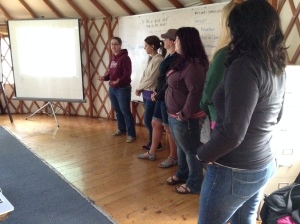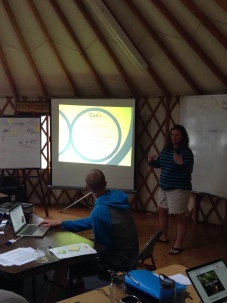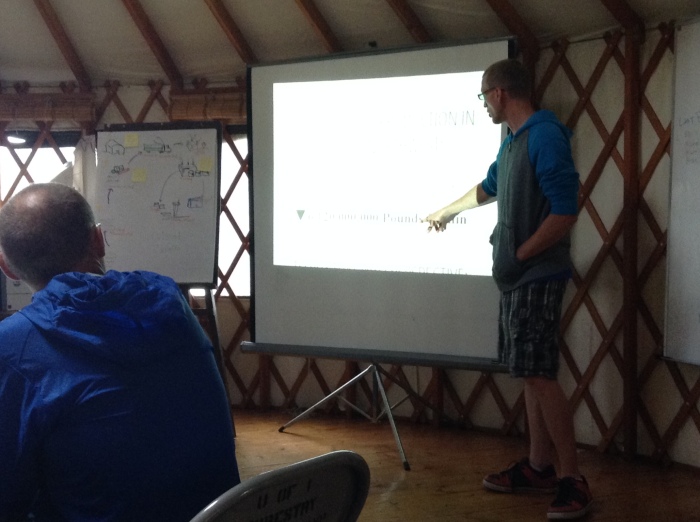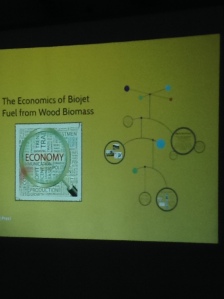We were dazzled, amazed, and enlightened by today’s “Lens Presentations”. The three lenses through which we have been considering the impacts of bio jet fuel and the associated supply chain impacts include Environmental, Social, and Economic. After intensive investigative research, each team arrived at a similar conclusion regarding the impact of woody biomass energy production and consumption in the Pacific Northwest: proceed with caution.
The presentations are here:
As we concluded our MOSSfully engaging week together, we formulated the following three principles:
1) Just because you can do something, doesn’t mean you should.
2) There is strength in diversity.
3) Don’t expect to find one perfect solution.







After seeing the presentations, I am very impressed by the detail and thoroughness of the groups. I am especially impressed with the economic breakdown of the whole process. I believe any change usually comes down to the economic feasibility of the idea. There has to be some money to be made at the end of the day or it is just another pipe dream. The consensus to proceed with caution makes the most sense as it is hard to gauge the effects on the environment until you actually start doing it. I would hate to see the scenic beauty of these areas suffer but I am totally down with figuring out new energy sources, especially if we are recycling refuse to get it done. I definitely would like to see this process go forward under constant supervision.
The main thing I take away from this study is the process itself. I am a social studies teacher and I am constantly trying to get kids to formulate opinions based not on what their parents tell them or what they see or hear on tv; but based on research. The idea of putting up a thesis statement then having the kids become researchers into facts that help and hurt their initial opinions will lead to educated opinions therefore smarter citizens.
I learned that using small hands on experiments with items they are already familiar will be a considerable help in forming lesson plans. It would be more of a discovery learning approach then a teacher-centered methodology.
I am not particularly interested in science but am thankful all you science geeks are doing your thing to make the world a more understandable place as well as coming up with the next big thing – maybe the thing that merges how to live in a cleaner environment while showing the business interests how to make a buck by embracing newer, greener energy sources.
Nice job.
Thanks for these thoughts! We talked about how this process (of inquiry) is transferrable beyond biofuels. Lots of things can be explored, as you say, by posing a big question and then figuring out what needs to be known to come to a conclusion. We all ended up with different conclusions — and that’s okay! Reasonable people come to different conclusions based on the same set of facts. This is where the social studies piece really comes into play — we make decisions based on what we value, and we value lots of different things that sometimes compete with each other. Trying to find a situation that satisfies a wide range of values (like economic, social and environmental sustainability) is really really tough, but it’s pretty interesting to try!
The presentations bring up most the questions or concerns that I could think of. Well done. Great tools in showing how people can discuss pros and cons and work out differences, which is great to teach students. I may have missed it but I am still curious as to whether or not certain trees will yield greater amounts of bio-fuel? (lignin)
I was attracted to the final three principles that you developed, specifically the second: There is strength in diversity. I think this is a great principle in many situations. I think that finding a different, perhaps even better environmentally safe way of developing bio jet fuel takes looking at things differently with different perspectives. This is also a topic that can be discussed and explored in lower grades as well.
Also, excellent job on the prezis, I appreciated having that visual representation of the three impacts.
The presentations are great for me as a teacher. It helps me organize my thoughts on the various aspects of the biojet fuel project. Good big picture tool. Next is – ok what activities do I do to help students arrive at the same overall understanding?!
Great question RL! Since we used (mostly) a “problem-based” approach, the path may be different each time we do it. But I did post the sequence of activities in the resource section of the site here that we did along with the overall inquiry. At the beginning of the week, we divided the group into three teams who had the assignment of answering the question “Is this a good idea, and how do we know?” through three different lenses — environmental, economic and social. Then, we did a series of hands-on activities plus we had some lectures. At the same time, we recommended some places to find additional resources. Those places are:
http://nararenewables.org
especially the newsletters, found here:http://nararenewables.org/news/newsletter
http://woodtobiofuel.org/
http://energliteracyprinciples.org
Energy Information Administration: EIA.gov
Great job on the presentations! They were all easy to understand. Originally going into the week I initially thought why not create bio jet fuel with woody biomass, but after looking at the presentations, there is definitely some room for thought, pondering, questions and more research involved. I love the three principals you concluded with and all three can be applied to life in general! Good job! Well done!
The presentations allow for a big picture look at the issue. While there will always be pros and cons to each issue, looking at the issue in its entirety allows for thoughtful decisions to be made. This whole process has been thought provoking with specifically this issue but also my own teaching practices and how to include inquiry as a focus in my teaching.